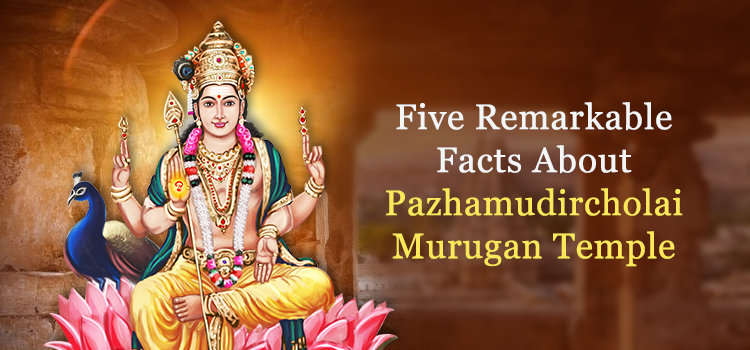Pazhamudircholai Murugan Temple is dedicated to Lord Muruga, who is the younger son of Lord Shiva and Goddess Parvati. The temple stands atop a thickly forested hill around 1100 feet above sea level. The Pazhamudircholai temple is the 6th of the Arupadai Veedus (abodes) of Murugan. The temple lies around 25 km north of Madurai in Tamil Nadu. Many ancient Tamil literary works like the Pattupattu, Ettuthokai, and Silappathikaram have praised this Lord Murugan temple.

Pazhamudhircholai Temple History
The SthalaVriksha here is a Jamun (Indian Blackberry) tree. Its fruits ripen during the Skanda Sashti festival, though it is not the season for it. The temple that existed during the Sangam period did not exist in Arunagirinathar’s time. The present temple was recently constructed. Arunagirinathar has sung praises of this temple in the work, Tiruppukazh. He sang 16 Tiruppugazh to Pazhamuthircholai Muruga. Lord Ganesha’s idol is on Muruga’s right side.
There are many interesting things about this famous temple. Let us see 5 of them.
Avvaiyar and Murugan
Avvaiyar was a poetess and great devotee of Lord Murugan. Once, she decided to visit the Murugan temple in Pazhani, which was situated on top of a big hill. As she neared the temple, she felt tired and decided to sit under a Jamun tree for a while to take some rest. Suddenly, she heard a boy’s voice. It seemed to come from above her. She looked up to find a young lad sitting on a branch of the Jamun tree.
He asked her if she wanted some fruit. Avvaiyar nodded in agreement. The boy said he would shake the tree so that the fruits would fall down from the tree. But he had a doubt. He asked her if she wanted hot or cold fruits. Avvaiyar was perplexed. How could the fruit be hot? When she asked him, he just smiled enigmatically and repeated his question.
Suddenly, it dawned on the poetess that the boy was testing her. She had assumed that he was an illiterate boy, and she had been very proud of her own knowledge. But the young boy had brought her down to earth by asking her such a clever and tricky question. If the fruit fell to the ground, it would be coated with dirt, and she would have to blow on it to remove the dirt. But it would appear as though the fruit was hot, and she was trying to cool it. This was the hidden meaning behind the boy’s question.
Avvaiyar was humbled by the boy’s intelligence and clever word-play. She asked him who he really was. The boy then revealed his true form. He was none other than Lord Muruga himself. Avvaiyar was very happy and felt blessed to have received the Lord’s darshan. Even today, people believe that this incident occurred under a tree near the temple, and they worship it even now.
Lord Muruga is Present with Both Consorts
At this temple, only the Vel (Muruga’s weapon, the lance) was worshipped as the Moolavar or the main deity in ancient times. But later, an idol of Lord Muruga with his consorts Valli and Deivanai was installed in the temple. Murugan is worshipped as Jnana Shakti in this temple, while Goddess Valli is Iccha Shakti and Goddess Deivanai is Kriya Shakti.
There are 6 Arupadai veedus or abodes of Lord Muruga in Tamil Nadu. Of these, this is the only temple where he is present, along with Valli and Deivanai. Many devotees visit the temple to seek Muruga’s blessings for removing obstacles to conceiving children, marriage, education, etc.
The Jamun Tree
The Jamun or Naval tree usually yields fruit during the Tamil months of Aadi and Aavani (July-August and August – September, respectively). But the Jamun tree in this temple compound yields fruit in Aippasi (October-November) month. It is during this month that the famous Skanda Shasti festival of Lord Murugan takes place. It is truly a miracle.
Noopura Ganga
There is a natural and perennial spring called Noopura Ganga or Silambaru here, and also a temple dedicated to Raakkayi Amman on top of the hill. Devotees who visit the temple have a dip in this sacred spring, which they believe came from Lord Vishnu’s bracelet. The belief is that people who worship at this shrine will be blessed with wealth and health.
A Place of Natural Beauty
Around the temple, one can see a great variety of flora and fauna. One can reach the temple on foot by hiking up the causeway through verdant forests. On the way, one can also see hordes of monkeys that roam freely in the verdant forest. Muruga’s consort, Valli, supposedly lived in this forest.
The water in it is sweet and has medicinal value. People perform rituals for departed souls in this spring. Hanuman Theertham and Garuda Theertham are some of the other springs here. The pond called Moolavavi is unique, as the water level in it rises during the summer season and falls during the winter. Sage Agasthiar supposedly constructed this pond. The Silapathikaram contains descriptions of these Teerthams, The Sidhar, Bhogar mentions the ‘Silambaru’ and the worship of the deity, Pathinettam Padi Karuppanaswamy, at this temple in his work, Jenana Sagaram.


Thank you very much for sharing, I learned a lot from your article. Very cool. Thanks.
There is a natural and perennial spring called Noopura Ganga or Silambaru here, and also a temple dedicated to Raakkayi Amman on top of the hill. Devotees who visit the temple have a dip in this sacred spring, which they believe came from Lord Vishnu’s bracelet. The belief is that people who worship at this shrine will be blessed with wealth and health.